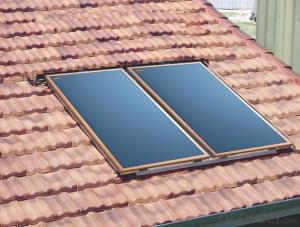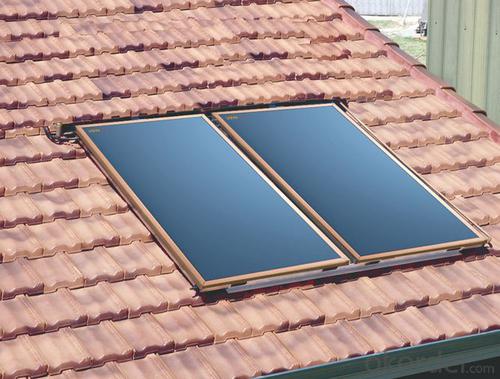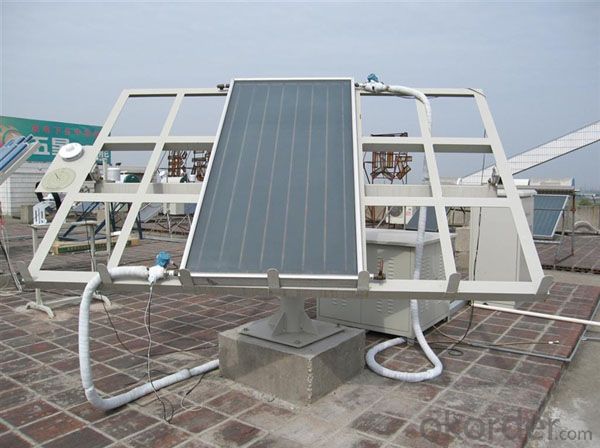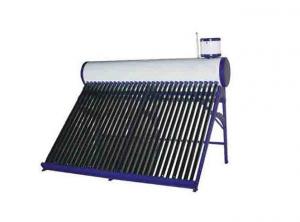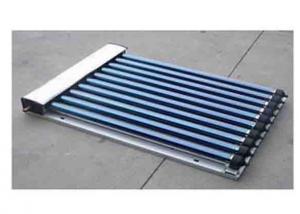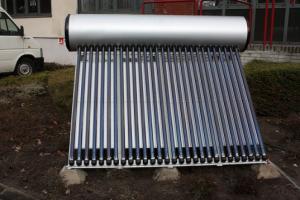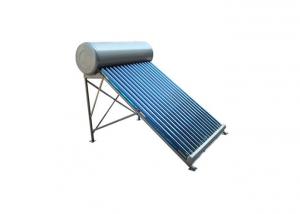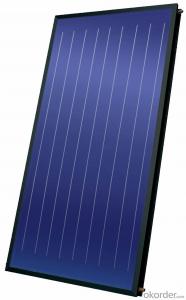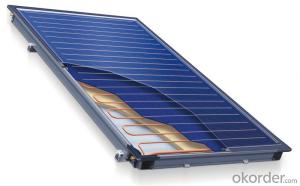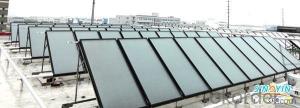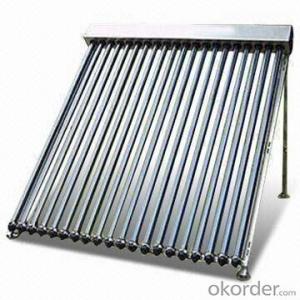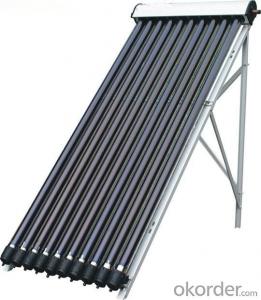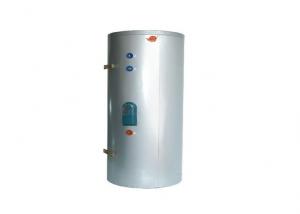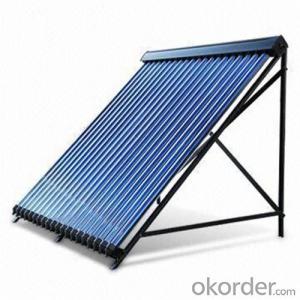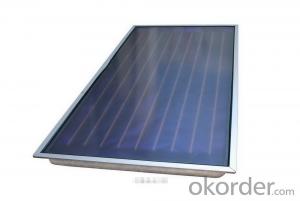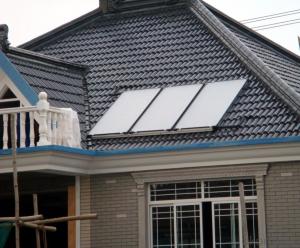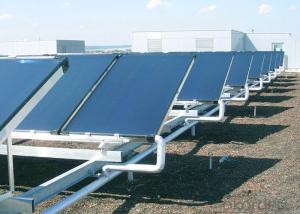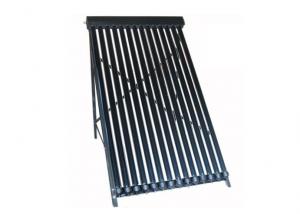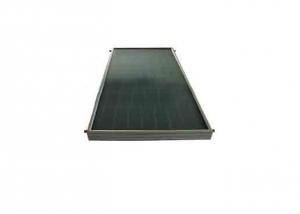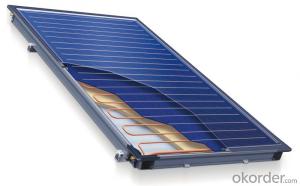Tesla Solar Collectors - Split Pressurized Vacuum Tube Solar Thermal Collectors
- Loading Port:
- Shanghai
- Payment Terms:
- TT OR LC
- Min Order Qty:
- 500 pc
- Supply Capability:
- 10000 pc/month
OKorder Service Pledge
OKorder Financial Service
You Might Also Like
Application:
Our flat plate solar thermal collector is suitable for residential or commercial solar water heating projects, such as hot water for real estate, hotel, factory hospital, school, swimming pool, central heating, floor heating, etc.
Warranty:
5 years international warranty for Flat Plate Solar Collector due to original quality problems.
Component Description:
Flat Plate Panel Solar Collector is one of the most wide-used solar collector with high efficiency, the selective coated absorber sheet absorbs up to 95% of available sunlight converting into usable heat, the heat is normally absorbed by water in the loop, or a freeze-resistant water mixture which is used to supplement hot water heating or house air heating.
--Glazing Glass: Toughened low-iron glass (glazing) protects the absorber from the outside environment while allowing through more than 91% of sunlight.
--Absorber: A thin sheet of aluminum is coated with a highly selective anodic oxidation / black chrome / blue titanium coating that is extremely efficient at absorbing sunlight and converting it into usable heat. The aluminum sheet is ultrasonically welded / laser welded to the copper riser pipes.
--Insulation: The insulation helps reduce heat loss from the sides and back of the collector. High-density polyurethane and glass wool to greatly reduce weight and heat lost of the collector.
--Riser & Header Pipe: Conforms to international standards, the header and riser pipes are brazed together to form a harp shaped heat exchanger that the solar system water or fluid circulates through. The absorber sheet is ultrasonically welded / laser welded to the riser pipes, thus transfers heat to the water or heat transfer fluid.
--Casing: Anodized aluminum alloy sheet seals the back and frame of the panel and adds to the rigidity of the collector. The rails in the frame are designed for easy mounting attachment.
Features:
1. Most wide-used and practical collector in solar water heating system
2. Wide applications for water heating, pool heating, space heating
3. Large solar heating capacity up to 500,000 Liter hot water
4. Much safe and stable performance with little maintenance
5. High efficient direct or indirect solar water heating
6. Strong adaptability to flat or slope roof installation
7. Easy installation and connection with simple structure
8. Super anti-freezing performance with glycol-water mixture
9. Applicable to passive and active solar water heating system
10. 10 years project installation experience
Advantages:
Comparing with vacuum tube solar collector:
1. High pressure solar collector
2. Anti-freezing with heat transfer liquid
3. More simple collector installation
4. More strong and safe collector with tempered glass glazing
5. Traditional solar collector with more market share
6. Enjoys much more popularity in warm area
7. No working angle limitation
Comparing with heat pipe solar collector:
1. More economical solar collector
2. More simple collector installation
3. More strong and safe collector with tempered glass glazing
4. Traditional solar collector with more market share
5. Enjoys much more popularity in warm area
6. No working angle limitation
- Q: Can solar collectors be used for heating saunas?
- Yes, solar collectors can be used for heating saunas. Solar thermal collectors, also known as solar water heaters, can be connected to the sauna's heating system to provide heat. These collectors use the sun's energy to heat water, which is then circulated through the sauna's heating system to warm up the sauna. This is an eco-friendly and cost-effective way to heat saunas, as it utilizes renewable energy sources.
- Q: Can solar collectors be used for heating greenhouses in winter?
- Yes, solar collectors can be used for heating greenhouses in winter. Solar collectors, such as solar water heating systems or solar air heaters, can capture and convert sunlight into heat energy. This heat energy can then be used to warm the greenhouse during colder months, helping to maintain a suitable temperature for plant growth.
- Q: Can solar collectors be used for generating electricity on spacecraft?
- Yes, solar collectors can be used for generating electricity on spacecraft. In fact, solar panels are a primary source of power for most spacecraft as they convert sunlight into electricity through photovoltaic cells. This sustainable and efficient method allows spacecraft to operate in space where traditional power sources like fossil fuels are not viable.
- Q: Can solar collectors be used for generating electricity on medical devices?
- Yes, solar collectors can be used for generating electricity on medical devices. By harnessing the power of the sun, solar collectors can provide a sustainable and renewable source of energy to power various medical devices, ensuring their continuous operation even in areas with limited access to electricity.
- Q: Can solar collectors be used for space exploration?
- Yes, solar collectors can indeed be used for space exploration. Solar collectors, also known as solar panels or photovoltaic (PV) arrays, are devices that convert sunlight into electricity. This electricity can be used to power the various instruments and systems required for space exploration. Solar panels are particularly advantageous in space exploration due to the abundance of sunlight in space. As there is no atmosphere to filter or block sunlight, solar panels can capture a significant amount of energy. This energy can be stored in batteries or used directly to power spacecraft, satellites, rovers, and other space exploration equipment. Solar panels have been extensively used in various space missions. For instance, the International Space Station (ISS) relies on solar panels to generate electricity needed for life support systems, communication, and scientific research. Additionally, many satellites and probes, such as the Hubble Space Telescope and Mars rovers like Curiosity and Perseverance, utilize solar panels to power their operations. Solar collectors are not only useful for generating electricity but also for providing thermal energy. In space, solar thermal collectors can be used to heat and cool spacecraft, maintain optimal temperature conditions, and support various experiments that require controlled thermal environments. Furthermore, solar collectors are lightweight and compact, making them ideal for space exploration. They can be easily integrated into the design of spacecraft without adding excessive weight or taking up too much space. This is crucial for launching missions into space, as reducing weight and maximizing payload capacity are essential. In conclusion, solar collectors are highly suitable for space exploration. They offer a reliable and sustainable source of energy, can be used for both electricity generation and thermal control, and are lightweight and compact. As we continue to explore our universe, solar collectors will continue to play a vital role in powering our space missions and expanding our knowledge of the cosmos.
- Q: Can solar collectors be used for heating community centers?
- Yes, solar collectors can be used for heating community centers. Solar thermal systems can collect and convert sunlight into heat, which can then be used for space heating and providing hot water in community centers. This renewable energy source is environmentally friendly, cost-effective, and sustainable for meeting the heating needs of community centers.
- Q: Can solar collectors be used for greenhouse heating?
- Yes, solar collectors can be used for greenhouse heating. Solar collectors, such as solar thermal panels, can absorb sunlight and convert it into heat energy, which can then be used to warm up the greenhouse. This sustainable heating method can help maintain optimal temperatures for plant growth and reduce reliance on traditional heating systems.
- Q: How do solar collectors affect the humidity of indoor swimming pools?
- Solar collectors have no direct impact on the humidity of indoor swimming pools. Their main function is to capture sunlight and convert it into heat energy in order to warm the pool water. This ensures a comfortable temperature for swimmers, without relying entirely on traditional energy sources. Nevertheless, it is worth noting that higher temperatures can lead to an increase in the evaporation rate of water. As solar collectors effectively heat up the pool water, they indirectly contribute to a potential rise in evaporation. Consequently, the humidity levels in the pool area may experience a slight increase. To regulate humidity levels, indoor swimming pools typically have appropriate ventilation and dehumidification systems installed. These systems work to control humidity by removing excess moisture from the air, preventing issues such as condensation, mold growth, and discomfort for swimmers. Therefore, while solar collectors themselves do not directly influence the humidity of indoor swimming pools, they can indirectly impact humidity levels by heating the pool water. This may require the use of suitable ventilation and dehumidification systems to maintain optimal conditions in the pool area.
- Q: Can solar collectors be used for heating car dealerships?
- Yes, solar collectors can be used for heating car dealerships. Solar thermal systems can efficiently capture the sun's energy to provide heat for various purposes, including space heating. By installing solar collectors on the rooftop or nearby areas, car dealerships can harness the power of the sun to generate heat, reducing their reliance on traditional heating systems and lowering their energy costs.
- Q: What is the effect of high winds on solar collectors?
- High winds can have a negative impact on solar collectors as they can cause physical damage to the panels, frames, and mounting systems. This can result in broken panels, misalignment, or detachment from their mounts. Additionally, strong winds can increase the pressure on the collectors, leading to structural stress and potential failure. Therefore, it is crucial to design solar installations with proper wind load calculations and robust mounting systems to withstand high wind conditions.
Send your message to us
Tesla Solar Collectors - Split Pressurized Vacuum Tube Solar Thermal Collectors
- Loading Port:
- Shanghai
- Payment Terms:
- TT OR LC
- Min Order Qty:
- 500 pc
- Supply Capability:
- 10000 pc/month
OKorder Service Pledge
OKorder Financial Service
Similar products
Hot products
Hot Searches
